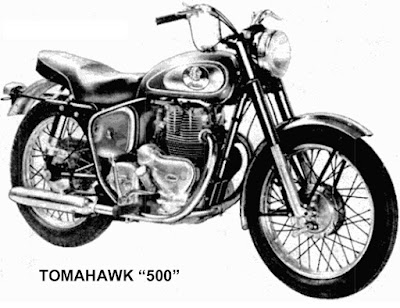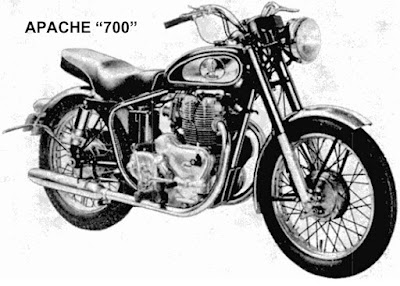 |
| They looked American but Indian's 1958 motorcycles were all Royal Enfield. |
"West Coast Woodsman" was the Royal Enfield's factory name for a 500cc single-cylinder motorcycle, exported to the United States in the 1950s to be badged and sold as an Indian motorcycle.
Oddly, Indian dealers in the United States apparently didn't market it as the West Coast Woodsman: they called it the "Westerner."
Graham Scarth recently explained this source of confusion in model names to a Royal Enfield enthusiast in the UK who purchased an Indian Westerner from the United States and began to wonder about its history.
Graham is chairman of the Royal Enfield Owners Club (UK) and has made a study of Royal Enfields produced at the British factories.
Graham attached to his response copies of a period Cycle magazine story entitled "Seven New Indians for 1958." He was kind enough to copy me on this.
Needless to say, the article, which includes the Westerner, really takes me back. I would have been seven years old when it appeared.
"Royal Enfield" isn't even mentioned in the article, although Royal Enfield, not Indian, built all seven of the motorcycles. The fiction is maintained throughout that these motorcycles were produced by the Indian Company of Springfield, Mass.
Ironically, although Royal Enfield wasn't using its own name in the United States at this point, the full range of motorcycles it delivered to Indian would be something any full-line brand would envy today.
It's fair to say that we haven't seen anything like this breadth of choices from Royal Enfield until very recent times, with Royal Enfield India now seemingly introducing a new model every few months.
This is the way it was in 1958, as Cycle reported:
"Indian this year is introducing the largest group of models they have produced in many years. Al West, Indian's vice-president in charge of sales, has described the new line as having 'more of everything.'"
In fact, Indian didn't produce anything for 1958. Its whole line had come from Royal Enfield of England since 1955, and by 1958 it was an amazing line-up.
There was the 148cc two-stroke "Lance" in bright Sahara Yellow enamel. It was the direct descendant of the famous Royal Enfield Flying Flea, by then being sold in the UK as the Ensign.
 |
| The 1958 Indian Lance two-stroke was painted brilliant yellow. |
There was the trail-ready 248cc "Hounds Arrow" in Chinese Red paint. It came with high-mounted exhaust for wading rivers and a detachable headlamp for competition work. UK customers would have considered it a Clipper set up for trials work. (Oddly, a more traditional road version of the Clipper, called the Indian "Fire Arrow," wasn't mentioned in this article but was available for 1958.)
 |
| The Indian Hounds Arrow was a Royal Enfield Clipper at heart. |
Also in trail trim was the 500cc "Woodsman," in Indian Red with quick detachable headlight, alloy head and alloy barrel with cast iron liner, and 2-by-21-inch front wheel. In Britain it would have been a Bullet set up for trials.
 |
| The Indian Woodsman took the Royal Enfield Bullet off road. |
The "Westerner" had its "frame, engine, lubrication, fenders, gas tank and finish same as 1958 Woodsman." But it was the more hardcore competition machine, with no lighting equipment front or rear, special foot pegs, special "motocross" forks and 19-inch wheel in front, and a steering damper.
 |
| The Indian Westerner was the hot way to get there off road. |
The "Tomahawk" 495cc twin promised refined cruising in "distinctive black and metallic blue paint" and "sport type chrome plated steel fenders." Except for the American style cow horn handlebars this would have been called the Meteor Minor in England.
 |
| The Indian Tomahawk was graceful, outside of its handlebars. |
High-speed touring was yours with the "Trailblazer" 692cc twin in "distinctive black or new metallic red colors on gas tank, fenders, toolbox and chain guard. Black enamel fork, outer covers and frame."
 |
| With all the other off-road models, why name the road bike "Trailblazer?" |
Also distinctive were the full fenders with a "flare" at the very tail of the rear fender, a chrome-plated tip on the edge of the front fender and the chrome-plated Indian head atop the front fender. The high-arching "Western" handlebars and absence of the casquette and pilot lights would have forced someone from the UK to squint hard to recognize a Super Meteor here.
The "Apache" 692cc twin was a Trailblazer with an eye on racing. Its quick-detach headlight and slim "light-weight" fenders, and the standard 150-mph speedometer and 8,000 rpm tachometer fitted as standard equipment give away its performance hopes.
 |
| Quick-release headlamp signaled that the Indian Apache was ready to duel. |
They signal the presence of standard "quick-lift cams" and 9-1 fuel compression, the highest reported in the article. A UK resident might have considered the Apache a hot-rod Super Meteor.
The November, 1957 Cycle article specifically notes that the seven "Indian" motorcycles it describes are "brand new additions to their line of motorcycles for 1958." (Hyperbole: only the Lance and Westerner names were new to Indian's catalog of rebadged Royal Enfields.)
But where was the most famous Indian nameplate of all, the "Chief"? Produced since 1922, the Chief was Indian's hefty and powerful Big Twin, used by police departments. The Chief went to war with Allied armies in World War II and it was the only pre-war Indian model produced after the war.
Production of the big Chief ended in 1953, when Indian ceased making its own motorcycles entirely.
A new Chief would eventually emerge: it would be yet another Royal Enfield 692cc twin, a modified Trailblazer with extended wheelbase and fat, 16-inch wheels. The Royal Enfield version of the Indian Chief wasn't ready for 1958, however, and so was not included in the Cycle article.
"The Chief is introduced for the 1959 model year with the first ones dispatched in October '58," Graham explained.
In 1959 Royal Enfield would send Indian no less than 10 different models to sell, including the Chief, the tricycle "Patrol Car" (handy for meter maids) and two versions of the little two-stroke Lance: the original, now dubbed Lance I and a near-identical version restricted to under five horsepower, the Lance II.
That would be in the end. In 1960 Royal Enfield would again start selling its motorcycles in the United States under its own name, ending its connection to Indian (Indian dealers would get Matchless bikes instead!).
The exception, again, was the Chief, the fat-tired motorcycle Indian would continue to source from Royal Enfield for 1961. The big Chief was big business. Graham counts 800 delivered for 1959 through 1961.
 |
| Royal Enfield's Chief continued into 1961 as a "Matchless/Indian." |
The 1955-1959 Indians are a curious chapter in Royal Enfield history. They offer a vision of an alternative universe in which British motorcycles dress up as Americans. What is really surprising is the wide range of Royal Enfield Indians offered, many quite different from Royal Enfield products marketed in Britain at the time.
You can read copies of the Cycle articles introducing the Indian line-up of Royal Enfields for 1955, 1956, 1958 and 1959 at this link. None of the articles mention that the motorcycles are Royal Enfields!
























Indian motorcycles stopped pretending with the Matchless models, not bothering to even re-badge them. I believe the "Indian" branding was merely something of convenience to gain a dealer network so the importer could ultimately sell AJS/Matchless and Royal Enfield. Neither had the strong dealer network of Triumph, BSA or Norton.
ReplyDeleteI have a westerner that was sold here new. It sits unrestored, still in orginial paint, but needs a complete restoration. I have owned 6 of the 59 chiefs. I do not know if there are any engine changes, internally. It came with a 10 tt carb, which I lack. One of the chiefs I owned was the first shipped and sold here, I still have the documentation somewhere. 1.24 cents in tire tax, and shipped on the s.s. American scientist, if I remember correctly. My Westerner is in track trim, open pipe, and unlike the woodsman it has fork ears with no headlight provision. Therefore, I think the statement that Westerners we're only woodsman is incorrect. In addition, the chiefs had one inch handlebars. My understanding from Graham is that only 133 of this model was produced.
ReplyDeleteThank you for adding these details.
DeleteAnonymous would you ever sell a Chief?
DeleteI have a 1959 trailblazer, original except for earlier style mufflers. Mine has the “chief” running lights which make it look a lot like a chief at first glance.
ReplyDeleteAs a teenager my favorite motorcycle was a Royal Enfield Interceptor. These Enfield twins were just cool motor scooters! Having an Enfield with Indian paraphernalia all over it makes it especially “special”. I have never seen another one in person. I was happy to find your thread. Thanks for taking the time to make information on these old bikes available.
I have a trailblazer, and, I have a light bar. Can you explain how they are wired into the bike?
DeleteI have an engine, gearbox, and Magneto, which is a 1958 woodman, I had all the numbers verified with Graham at the Royal Enfield owners club in the UK would love to find a home for it
ReplyDelete